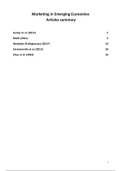Marketing in Emerging Economies
Articles summary
Kumar et al. (2015) 2
Sheth (2011) 5
Westjohn & Magnusson (2017) 14
Zarantonello et al. (2013) 18
Zhou et al. (2010) 19
1
,Kumar et al. (2015)
Past research has stressed on distribution and retailing as being one of the biggest challenges of
doing business in emerging markets.
● developed markets have an organized retail sector which is characterized by retailers
who offer a large number of outlets (usually spread out nationally), large product
assortments and large stores.
○ examples: Walmart and Kroger
● emerging markets have an unorganized retail sector1 which is characterized by a large
number of small, independently owned stores that stock fewer products.
○ examples: kirana stores, grocers, street vendors.
One of the main challenges when operating in highly unorganized and unstructured retail
settings is that brand managers are forced to depend heavily on local intermediaries
(wholesalers as well as retailers) to ‘push’ the brand in the market, leverage the brand across
various retail formats and, therefore, ensure success of the brand.
● the distribution decision is more difficult to make since the unstructured nature of the
market provides managers with little information (in the form of data) to make optimal
distribution decisions.
● The issues outlined above are more complicated for CPG 2manufacturers that manage
multiple brands in multiple products forms across multiple distribution formats (small
retail, street vendor, big retailer)
○ challenge: aligning brand, store format and product form in order to maximize
profits.
1
→ Sarma(2011) defines unorganized retail sector as ‘outlet run locally by the owner or caretaker of a
shop that lacks technical and accounting standardization’’
2
CPG = Consumer Packaged Goods are products that are sold quickly and at a relatively low-cost
● examples are: toiletries, beverages and packaged foods
● Consumer packaged goods (CPG) refers to a broad spectrum of manufacturers, sellers, and
marketers of physical goods (typically packaged in some way, shape or form) used by consumers
and sold through a retailer.
2
,Theoretical framework3
The figure above describes the decision process that CPG manufacturers can follow in order to
maximize profits using the distribution function in emerging markets.
● Given the overall objective of profit maximization, CPG manufacturers first need to
understand the unique aspects if the retail landscape in emerging markets.
○ specifically, managers need to analyse the different store format types and the
level of penetration in each store format within the market.
● Furthermore, for the managers who manage brand portfolios with products being
offered in multiple forms, it is important to achieve alignment of brand, product forms,
and store format, especially in an emerging market.
● Next, in order to understand the impact of various distribution formats on overall sales,
a marketing mix model that account for challenges such as endogeneity, brand level
heterogeneity and product for independencies is developed
○ pull strategies - work toward attracting the customer to the store and thus
creating demand. The marketing mix used for pull strategy often includes price
and advertising.
○ push strategies - aim to deliver the right product at the right place at the right
time.
The above decision framework is applicable across all the emerging markets where there are
multiple store formats having visible differences and catering to different customer segments
-Marketing in an Emerging Economy-
Pricing
Microeconomic theory predicts that consumers in emerging markets are more price sensitive
than their counterparts in developed markets due to stricter budget constraints.
→ Negative relationship of price with sales.
3
see figure above
3
, ● However, the impact of price can be different depending on the product form 4being
considered, due to differences in usage patterns and target consumer segments.
● In addition, price elasticity could vary, depending on the product form being considered.
○ example → Kumar et al. (2009) show that laundry detergent category is inelastic
in emerging markets.
Advertising
● Developed markets: advertising plays a significant role in creating awareness and has
strong trend-setting affects on sales.
● Emerging Economies: Burgess and Steenkamp (2006) predict that advertising elasticities
in emerging economies will be high since emerging markets
have a considerable pool of consumers who are first
purchasers.
Marketing Mix in Emerging Economies
In the emerging markets, consumers are extremely sensitive to the
marketing mix and would readily switch between product forms
where the marketing mix is viewed to be unfavorable.
● example → w hen the price increases of product form A,
consumers would switch to downward to a lower priced
category (say product form B).
Further, it is possible that because of sales promotion factors and
in-store promotions, consumers may change their purchase decision.
Perhaps the most intriguing element of marketing mix in emerging markets is the effect of
distribution on a firm’s success. Emerging markets are very unique with regard to their
distribution channels. Kumar et al. (2013) suggest that a successfully designed distribution
network can lead to higher profitable customer loyalty in an emerging market.
-Multichannel Distribution-
Multichannel distribution strategy → involves selling merchandize/services to consumers
through more than one store/distribution format.
● In emerging markets, various channels are: kirana stores, owner-managed general
stores and so forth.
Retailing in an emerging market across multiple distribution formats comes with its challenges
and benefits:
● challenges:
1. operational complexities in terms of managing a large number of stock-keeping
units (SKUs)
2. frequent modifications in the retail mix.
3. dealing with multiple retail agents.
4
example: solid, liquid, gels
4





